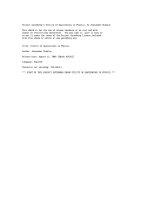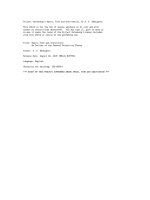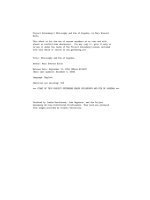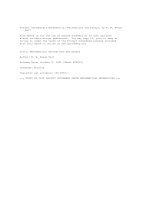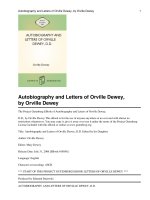Project Gutenberg’s Mathematical Recreations and Essays pptx
Bạn đang xem bản rút gọn của tài liệu. Xem và tải ngay bản đầy đủ của tài liệu tại đây (2.51 MB, 377 trang )
Project Gutenberg’s Mathematical Recreations and Essays, by W. W. Rouse
Ball
This eBook is for the use of anyone anywhere at no cost and with
almost no restrictions whatsoever. You may copy it, give it away or
re-use it under the terms of the Project Gutenberg License included
with this eBook or online at www.gutenberg.org
Title: Mathematical Recreations and Essays
Author: W. W. Rouse Ball
Release Date: October 8, 2008 [EBook #26839]
Language: English
Character set encoding: ISO-8859-1
***
START OF THIS PROJECT GUTENBERG EBOOK MATHEMATICAL RECREATIONS
***
First Edition, Feb. 1892. Reprinted, May, 1892.
Second Edition, 1896. Reprinted, 1905.
MATHEMATICAL
RECREATIONS AND ESSAYS
BY
W.W. ROUSE BALL
Fellow and Tutor of Trinity College, Cambridge.
FOURTH EDITION
London:
MACMILLAN AND CO., Limited
NEW YORK: THE MACMILLAN COMPANY
[All rights reserved.]
Produced by Joshua Hutchinson, David Starner, David Wilson and
the Online Distributed Proofreading Team at
Transcriber’s notes
Most of the open questions discussed by the author were
settled during the twentieth century.
The author’s footnotes are labelled using printer’s marks
*
;
footnotes showing where corrections to the text have been
made are labelled numerically
1
.
Minor typographical corrections are documented in the L
A
T
E
X
source.
This document is designed for two-sided printing. Consequently,
the many hyperlinked cross-references are not visually
distinguished. The document can be recompiled for more
comfortable on-screen viewing: see comments in source L
A
T
E
X
co de.
PREFACE TO THE FIRST EDITION.
The following pages contain an account of certain mathematical
recreations, problems, and speculations of past and present times. I
hasten to add that the conclusions are of no practical use, and most
of the results are not new. If therefore the reader proceeds further he
is at least forewarned.
At the same time I think I may assert that many of the diversions—
particularly those in the latter half of the book—are interesting, not
a few are associated with the names of distinguished mathematicians,
while hitherto several of the memoirs quoted have not been easily ac-
cessible to English readers.
The book is divided into two parts, but in both parts I have in-
cluded questions which involve advanced mathematics.
The
first part consists of seven chapters, in which are included var-
ious problems and amusements of the kind usually called mathematical
recreations. The questions discussed in the first of these chapters are
connected with arithmetic; those in the second with geometry; and
those in the third relate to mechanics. The fourth chapter contains
an account of some miscellaneous problems which involve both num-
ber and situation; the fifth chapter contains a concise account of magic
squares; and the sixth and seventh chapters deal with some unicursal
iii
iv PREFACE
problems. Several of the questions mentioned in the first three chap-
ters are of a somewhat trivial character, and had they been treated in
any standard English work to which I could have referred the reader, I
should have pointed them out. In the absence of such a work, I thought
it best to insert them and trust to the judicious reader to omit them
altogether or to skim them as he feels inclined.
The second part consists of five chapters, which are mostly histori-
cal. They deal respectively with three classical problems in geometry—
namely, the duplication of the cube, the trisection of an angle, and the
quadrature of the circle —astrology, the hypotheses as to the nature of
space and mass, and a means of measuring time.
I have inserted detailed references, as far as I know, as to the sources
of the various questions and solutions given; also, wherever I have given
only the result of a theorem, I have tried to indicate authorities where
a proof may be found. In general, unless it is stated otherwise, I have
taken the references direct from the original works; but, in spite of
considerable time spent in verifying them, I dare not suppose that they
are free from all errors or misprints.
I shall be grateful for notices of additions or corrections which may
occur to any of my readers.
W.W. ROUSE BALL
Trinity College, Cambridge.
February, 1892.
NOTE TO THE FOURTH EDITION.
In this edition I have inserted in the earlier chapters descriptions of
several additional Recreations involving elementary mathematics, and
I have added in the second part chapters on the History of the Mathe-
matical Tripos at Cambridge, Mersenne’s Numbers, and Cryptography
and Ciphers.
It is with some hesitation that I include in the book the chapters on
Astrology and Ciphers, for these subjects are only remotely connected
with Mathematics, but to afford myself some latitude I have altered
the title of the second part to Miscellaneous Essays and Problems.
W.W.R.B.
Trinity College, Cambridge.
13 May, 1905.
v
TABLE OF CONTENTS.
PART I.
Mathematical Recreations.
Chapter I. Some Arithmetical Questions.
PAGE
Elementary Questions on Numbers (Miscellaneous) . . . . . . 4
Arithmetical Fallacies . . . . . . . . . . . . . . . . . . . . . . 20
Bachet’s Weights Problem . . . . . . . . . . . . . . . . . . . . 27
Problems in Higher Arithmetic . . . . . . . . . . . . . . . . . 29
Fermat’s Theorem on Binary Powers . . . . . . . . . . . . 31
Fermat’s Last Theorem . . . . . . . . . . . . . . . . . . . . 32
Chapter II. Some Geometrical Questions.
Geometrical Fallacies . . . . . . . . . . . . . . . . . . . . . . . 35
Geometrical Paradoxes . . . . . . . . . . . . . . . . . . . . . . 42
Colouring Maps . . . . . . . . . . . . . . . . . . . . . . . . . . 44
Physical Geography . . . . . . . . . . . . . . . . . . . . . . . 46
Statical Games of Position . . . . . . . . . . . . . . . . . . . . 48
Three-in-a-row. Extension to p-in-a-row . . . . . . . . . 48
Tesselation. Cross-Fours . . . . . . . . . . . . . . . . . . 50
Colour-Cube Problem . . . . . . . . . . . . . . . . . . . . 51
vi
TABLE OF CONTE NTS. vii
PAGE
Dynamical Games of Position . . . . . . . . . . . . . . . . . . 52
Shunting Problems . . . . . . . . . . . . . . . . . . . . . . 53
Ferry-Boat Problems . . . . . . . . . . . . . . . . . . . . . 55
Geodesic Problems . . . . . . . . . . . . . . . . . . . . . . 57
Problems with Counters placed in a row . . . . . . . . . . 58
Problems on a Chess-board with Counters or Pawns . . . . 60
Guarini’s Problem . . . . . . . . . . . . . . . . . . . . . . 63
Geometrical Puzzles (rods, strings, &c.) . . . . . . . . . . . . 64
Paradromic Rings . . . . . . . . . . . . . . . . . . . . . . . . . 64
Chapter III. Some Mechanical Questions.
Paradoxes on Motion . . . . . . . . . . . . . . . . . . . . . . . 67
Force, Inertia, Centrifugal Force . . . . . . . . . . . . . . . . . 70
Work, Stability of Equilibrium, &c. . . . . . . . . . . . . . . . 72
Perpetual Motion . . . . . . . . . . . . . . . . . . . . . . . . . 75
Models . . . . . . . . . . . . . . . . . . . . . . . . . . . . . . . 78
Sailing quicker than the Wind . . . . . . . . . . . . . . . . . . 79
Boat moved by a rope inside the boat . . . . . . . . . . . . . 81
Results dependent on Hauksbee’s Law . . . . . . . . . . . . . 82
Cut on a tennis-ball. Spin on a cricket-ball . . . . . . . 83
Flight of Birds . . . . . . . . . . . . . . . . . . . . . . . . . . 85
Curiosa Physica . . . . . . . . . . . . . . . . . . . . . . . . . . 86
Chapter IV. Some Miscellaneous Questions.
The Fifteen Puzzle . . . . . . . . . . . . . . . . . . . . . . . . 88
The Tower of Hano¨ı . . . . . . . . . . . . . . . . . . . . . . . 91
Chinese Rings . . . . . . . . . . . . . . . . . . . . . . . . . . . 93
The Eight Queens Problem . . . . . . . . . . . . . . . . . . . 97
Other Problems with Queens and Chess-pieces . . . . . . . . . 102
The Fifteen School-Girls Problem . . . . . . . . . . . . . . . . 103
viii TABLE OF CO NTENTS.
PAGE
Problems connected with a pack of cards . . . . . . . . . . . . 109
Monge on shuffling a pack of cards . . . . . . . . . . . . . 109
Arrangement by rows and columns . . . . . . . . . . . . . 111
Determination of one out of
1
2
n(n + 1) given couples . . . . 113
Gergonne’s Pile Problem . . . . . . . . . . . . . . . . . . . 115
The Mouse Trap. Treize . . . . . . . . . . . . . . . . . . 119
Chapter V. Magic Squares.
Notes on the History of Magic Squares . . . . . . . . . . . . . 122
Construction of Odd Magic Squares . . . . . . . . . . . . . . . 123
Method of De la Loub`ere . . . . . . . . . . . . . . . . . . . 124
Method of Bachet . . . . . . . . . . . . . . . . . . . . . . . 125
Method of De la Hire . . . . . . . . . . . . . . . . . . . . . 126
Construction of Eve n Magic Squares . . . . . . . . . . . . . . 128
First Method . . . . . . . . . . . . . . . . . . . . . . . . . 129
Method of De la Hire and Labosne . . . . . . . . . . . . . 132
Composite Magic Squares . . . . . . . . . . . . . . . . . . . . 134
Bordered Magic Squares . . . . . . . . . . . . . . . . . . . . . 135
Hyper-Magic Squares . . . . . . . . . . . . . . . . . . . . . . . 136
Pan-diagonal or Nasik Squares . . . . . . . . . . . . . . . . 136
Doubly Magic Squares . . . . . . . . . . . . . . . . . . . . 137
Magic Pencils . . . . . . . . . . . . . . . . . . . . . . . . . . . 137
Magic Puzzles . . . . . . . . . . . . . . . . . . . . . . . . . . . 140
Card Square . . . . . . . . . . . . . . . . . . . . . . . . . . 140
Euler’s Officers Problem . . . . . . . . . . . . . . . . . . . 140
Domino Squares . . . . . . . . . . . . . . . . . . . . . . . . 141
Coin Squares . . . . . . . . . . . . . . . . . . . . . . . . . 141
Chapter VI. Unicursal Problems.
Euler’s Problem . . . . . . . . . . . . . . . . . . . . . . . . . . 143
Definitions . . . . . . . . . . . . . . . . . . . . . . . . . . . 145
Euler’s Theorems . . . . . . . . . . . . . . . . . . . . . . . 145
Examples . . . . . . . . . . . . . . . . . . . . . . . . . . . 148
TABLE OF CONTE NTS. ix
PAGE
Mazes . . . . . . . . . . . . . . . . . . . . . . . . . . . . . . . 149
Rules for completely traversing a Maze . . . . . . . . . . . 150
Notes on the History of Mazes . . . . . . . . . . . . . . . . 150
Geometrical Trees . . . . . . . . . . . . . . . . . . . . . . . . 154
The Hamiltonian Game . . . . . . . . . . . . . . . . . . . . . 155
Knight’s Path on a Chess-Board . . . . . . . . . . . . . . . . . 158
Method of De Montmort and De Moivre . . . . . . . . . . 159
Method of Euler . . . . . . . . . . . . . . . . . . . . . . . 159
Method of Vandermonde . . . . . . . . . . . . . . . . . . . 163
Method of Warnsdorff . . . . . . . . . . . . . . . . . . . . 164
Method of Roget . . . . . . . . . . . . . . . . . . . . . . . 164
Method of Moon . . . . . . . . . . . . . . . . . . . . . . . 167
Method of Jaenisch . . . . . . . . . . . . . . . . . . . . . . 168
Number of possible routes . . . . . . . . . . . . . . . . . . 168
Paths of other Chess-Pieces . . . . . . . . . . . . . . . . . . . 168
x TABLE OF CO NTENTS.
PART II.
Miscellaneous Essays and Problems.
Chapter VII. The Mathematical Tripos.
PAGE
Medieval Course of Studies: Acts . . . . . . . . . . . . . . . . 171
The Renaissance at Cambridge . . . . . . . . . . . . . . . . . 172
Rise of a Mathematical School . . . . . . . . . . . . . . . . 172
Subject-Matter of Acts at different periods . . . . . . . . . . . 172
Degree Lists . . . . . . . . . . . . . . . . . . . . . . . . . . . . 174
Oral Examinations always possible . . . . . . . . . . . . . . . 174
Public Oral Examinations become customary, 1710–30 . . . . 175
Additional work thrown on Moderators. Stipends raised . 175
Facilitates order of merit . . . . . . . . . . . . . . . . . . . 176
Scheme of Examination in 1750 . . . . . . . . . . . . . . . . . 176
Right of M.A.s to take part in it . . . . . . . . . . . . . . . 176
Scheme of Examination in 1763 . . . . . . . . . . . . . . . . . 177
Foundations of Smith’s Prizes, 1768 . . . . . . . . . . . . . . . 178
Introduction of a Written Examination, circ. 1770 . . . . . . . 179
Description of the Examination in 1772 . . . . . . . . . . . . . 179
Scheme of Examination in 1779 . . . . . . . . . . . . . . . . . 182
System of Brackets . . . . . . . . . . . . . . . . . . . . . . 182
Problem Papers in 1785 and 1786 . . . . . . . . . . . . . . . . 183
Description of the Examination in 1791 . . . . . . . . . . . . . 184
The Poll Part of the Examination . . . . . . . . . . . . . . 185
A Pass Standard introduced . . . . . . . . . . . . . . . . . . . 186
Problem Papers from 1802 onwards . . . . . . . . . . . . . . . 186
Description of the Examination in 1802 . . . . . . . . . . . . . 187
Scheme of Reading in 1806 . . . . . . . . . . . . . . . . . . . . 189
Introduction of modern analytical notation . . . . . . . . . . . 192
Alterations in Schemes of Study, 1824 . . . . . . . . . . . . . 195
Scheme of Examination in 1827 . . . . . . . . . . . . . . . . . 195
Scheme of Examination in 1833 . . . . . . . . . . . . . . . . . 197
All the papers marked . . . . . . . . . . . . . . . . . . . . 197
Scheme of Examination in 1839 . . . . . . . . . . . . . . . . . 197
TABLE OF CONTE NTS. xi
PAGE
Scheme of Examination in 1848 . . . . . . . . . . . . . . . . . 198
Creation of a Board of Mathematical Studies . . . . . . . . . 198
Scheme of Examination in 1873 . . . . . . . . . . . . . . . . . 199
Scheme of Examination in 1882 . . . . . . . . . . . . . . . . . 200
Fall in number of students reading mathematics . . . . . . 201
Origin of term Tripos . . . . . . . . . . . . . . . . . . . . . . . 201
Tripos Verses . . . . . . . . . . . . . . . . . . . . . . . . . 202
Chapter VIII. Three Geometrical Problems.
The Three Problems . . . . . . . . . . . . . . . . . . . . . . . 204
The Duplication of the Cube . . . . . . . . . . . . . . . . . . 205
Legendary origin of the problem . . . . . . . . . . . . . . . 205
Lemma of Hippocrates . . . . . . . . . . . . . . . . . . . . . . 206
Solutions of Archytas, Plato, Menaechmus, Apollonius, and
Sporus . . . . . . . . . . . . . . . . . . . . . . . . . . . . . 207
Solutions of Vieta, Descartes, Gregory of St Vincent, and
Newton . . . . . . . . . . . . . . . . . . . . . . . . . . . . 209
The Trisection of an Angle . . . . . . . . . . . . . . . . . . . . 210
Solutions quoted by Pappus (three) . . . . . . . . . . . . . . . 210
Solutions of Descartes, Newton, Clairaut, and Chasles . . . . 211
The Quadrature of the Circle . . . . . . . . . . . . . . . . . . 212
Incommensurability of π . . . . . . . . . . . . . . . . . . . . . 212
Definitions of π . . . . . . . . . . . . . . . . . . . . . . . . . . 213
Origin of symbol π . . . . . . . . . . . . . . . . . . . . . . . . 214
Methods of approximating to the numerical value of π . . . . 214
Geometrical methods of approximation . . . . . . . . . . . . . 214
Results of Egyptians, Babylonians, Jews . . . . . . . . . . 215
Results of Archimedes and other Greek writers . . . . . . . 215
Results of Roman surveyors and Gerbert . . . . . . . . . . 216
Results of Indian and Eastern writers . . . . . . . . . . . . 216
Results of European writers, 1200–1630 . . . . . . . . . . . 217
Theorems of Wallis and Brouncker . . . . . . . . . . . . . . . 220
Analytical methods of approximation. Gregory’s series . . . . 220
Results of European writers, 1699–1873 . . . . . . . . . . . 220
Geometrical approximations . . . . . . . . . . . . . . . . . . . 222
Approximations by the theory of probability . . . . . . . . . . 222
xii TABLE OF CONTENTS.
Chapter IX. Mersenne’s Numbers.
PAGE
Mersenne’s Enunciation of the Theorem . . . . . . . . . . . . 224
List of known results . . . . . . . . . . . . . . . . . . . . . . . 225
Cases awaiting verification . . . . . . . . . . . . . . . . . . . . 225
History of Investigations . . . . . . . . . . . . . . . . . . . . . 226
Methods used in attacking the problem . . . . . . . . . . . . . 230
By trial of divisors of known forms . . . . . . . . . . . . . 231
By indeterminate equations . . . . . . . . . . . . . . . . . 233
By properties of quadratic forms . . . . . . . . . . . . . . 234
By the use of a Canon Arithmeticus . . . . . . . . . . . . 234
By properties of binary powers . . . . . . . . . . . . . . . 235
By the use of the binary scale . . . . . . . . . . . . . . . . 235
By the use of Fermat’s Theorem . . . . . . . . . . . . . . . 236
Mechanical methods of Factorizing Numbers . . . . . . . . . . 236
Chapter X. Astrology.
Astrology. Two branches: natal and horary astrology . . . . . 238
Rules for casting and reading a horoscope . . . . . . . . . . . 238
Houses and their significations . . . . . . . . . . . . . . . . 238
Planets and their significations . . . . . . . . . . . . . . . 240
Zodiacal signs and their significations . . . . . . . . . . . . 242
Knowledge that rules were worthless . . . . . . . . . . . . . . 243
Notable instances of horoscopy . . . . . . . . . . . . . . . . . 246
Lilly’s prediction of the Great Fire and Plague . . . . . . . 246
Flamsteed’s guess . . . . . . . . . . . . . . . . . . . . . . . 246
Cardan’s horoscope of Edward VI . . . . . . . . . . . . . . 247
Chapter XI. Cryptographs and Ciphers.
A Cryptograph. Definition. Illustration . . . . . . . . . . . . . 251
A Cipher. Definition. Illustration . . . . . . . . . . . . . . . . 252
Essential Features of Cryptographs and Ciphers . . . . . . . . 252
Cryptographs of Three Types. Illustrations . . . . . . . . . . 253
Order of letters re-arranged . . . . . . . . . . . . . . . . . 253
Use of non-significant symbols. The Grille . . . . . . . . . 256
Use of broken symbols. The Scytale . . . . . . . . . . . . . 258
Ciphers. Use of arbitrary symbols unnecessary . . . . . . . . . 259
TABLE OF CONTE NTS. xiii
PAGE
Ciphers of Four Types . . . . . . . . . . . . . . . . . . . . . . 259
Ciphers of the First Type. Illustrations . . . . . . . . . . . 260
Ciphers of the Second Type. Illustrations . . . . . . . . . . 263
Ciphers of the Third Type. Illustrations . . . . . . . . . . 265
Ciphers of the Fourth Type. Illustrations . . . . . . . . . . 267
Requisites in a good Cipher . . . . . . . . . . . . . . . . . . . 268
Cipher Machines . . . . . . . . . . . . . . . . . . . . . . . . . 269
Historical Ciphers . . . . . . . . . . . . . . . . . . . . . . . . . 269
Julius Caesar, Augustus . . . . . . . . . . . . . . . . . . . 269
Bacon . . . . . . . . . . . . . . . . . . . . . . . . . . . . . 269
Charles I . . . . . . . . . . . . . . . . . . . . . . . . . . . . 269
Pepys . . . . . . . . . . . . . . . . . . . . . . . . . . . . . 271
De Rohan . . . . . . . . . . . . . . . . . . . . . . . . . . . 272
Marie Antoinette . . . . . . . . . . . . . . . . . . . . . . . 272
The Code Dictionary . . . . . . . . . . . . . . . . . . . . . 274
Poe’s Writings . . . . . . . . . . . . . . . . . . . . . . . . . 275
Chapter XII. Hyper-space.
Two subjects of speculation on Hyper-space . . . . . . . . . . 278
Space of two dimensions and of one dimension . . . . . . . . . 278
Space of four dimensions . . . . . . . . . . . . . . . . . . . . . 279
Existence in such a world . . . . . . . . . . . . . . . . . . 279
Arguments in favour of the existence of such a world . . . 280
Non-Euclidean Geometries . . . . . . . . . . . . . . . . . . . . 284
Euclid’s axioms and postulates. The parallel postulate . . . . 284
Hyperbolic Geometry of two dimensions . . . . . . . . . . . . 285
Elliptic Geometry of two dimensions . . . . . . . . . . . . . . 285
Elliptic, Parabolic and Hyperbolic Geometries compared . 285
Non-Euclidean Geometries of three or more dimensions . . . . 287
Chapter XIII. Time and its Measurement.
Units for measuring durations (days, weeks, months, years) . . 289
The Civil Calendar (Julian, Gregorian, &c.) . . . . . . . . . . 292
The Ecclesiastical Calendar (date of Easter) . . . . . . . . . . 294
Day of the week corresponding to a given date . . . . . . . . . 297
xiv TABLE OF CONTENTS.
PAGE
Means of measuring Time . . . . . . . . . . . . . . . . . . . . 297
Styles, Sun-dials, Sun-rings . . . . . . . . . . . . . . . . . 297
Water-clocks, Sand-clocks, Graduated Candles . . . . . . . 301
Clocks and Watches . . . . . . . . . . . . . . . . . . . . . 301
Watches as Compasses . . . . . . . . . . . . . . . . . . . . . . 303
Chapter XIV. Matter and Ether Theories.
Hypothesis of Continuous Matter . . . . . . . . . . . . . . . . 306
Atomic Theories . . . . . . . . . . . . . . . . . . . . . . . . . 306
Popular Atomic Hypothesis . . . . . . . . . . . . . . . . . 306
Boscovich’s Hypothesis . . . . . . . . . . . . . . . . . . . . 307
Hypothesis of an Elastic Solid Ether. Labile Ether . . . . . 307
Dynamical Theories . . . . . . . . . . . . . . . . . . . . . . . 308
The Vortex Ring Hypothesis . . . . . . . . . . . . . . . . . 308
The Vortex Sponge Hypothesis . . . . . . . . . . . . . . . 309
The Ether-Squirts Hypothesis . . . . . . . . . . . . . . . . 310
The Electron Hypothesis . . . . . . . . . . . . . . . . . . . 311
Speculations due to investigations on Radio-activity . . . . 311
The Bubble Hypothesis . . . . . . . . . . . . . . . . . . . . 313
Conjectures as to the cause of Gravity . . . . . . . . . . . . . 314
Conjectures to explain the finite number of species of Atoms . 318
Size of the molecules of bodies . . . . . . . . . . . . . . . . . . 320
Index . . . . . . . . . . . . . . . . . . . . . . . . . . . . . . . 323
Notices of some works—chiefly
historico-mathematical . . . . . . . . . . . . . . . . . 335
Project Gutenberg Licensing Information . . . . . . 355
PART I.
Mathematical Recreations.
“Les hommes ne sont jamais plus ing´enieux
que dans l’invention des jeux; l’esprit s’y trouve `a
son aise. . . . Apr`es les jeux qui d´ependent unique-
ment des nombres viennent les jeux o`u entre la situ-
ation. . . . Apr`es les jeux o`u n’entrent que le nombre
et la situation viendraient les jeux o`u entre le mou-
vement. . . . Enfin il serait a souhaiter qu’on eˆut un
cours entier des jeux, trait´es math´ematiquement.”
(Leibnitz: letter to De Montmort, July 29, 1715.)
1
CHAPTER I.
SOME ARITHMETICAL QUESTIONS.
The interest excited by statements of the relations between num-
bers of certain forms has been often remarked. The majority of works
on mathematical recreations include several such problems, which are
obvious to any one acquainted with the elements of algebra, but which
to many who are ignorant of that subject possess the same kind of
charm that some mathematicians find in the more recondite proposi-
tions of higher arithmetic. I shall devote the bulk of this chapter to
these elementary problems, but I append a few remarks on one or two
questions in the theory of numbers.
Before entering on the subject of the chapter, I may add that a
large proportion of the elementary questions mentioned here and in
the following two chapters are taken from one of two sources. The first
of these is the classical Probl`emes plaisans et d´electables, by C.G. Ba-
chet, sieur de M´eziriac, of which the first edition was published in 1612
and the second in 1624: it is to the edition of 1624 that the references
hereafter given apply. Several of Bachet’s problems are taken from the
writings of Alcuin, Pacioli di Burgo, Tartaglia, or Cardan, and possi-
bly some of them are of oriental origin, but I have made no attempt
to add such references. The other source to which I alluded above is
Ozanam’s R´ecr´eations math´ematiques et physiques. The greater por-
tion of the original edition, published in two volumes at Paris in 1694,
was a compilation from the works of Bachet, Leurechon, Mydorge, van
Etten, and Oughtred: this part is excellent, but the same cannot be
said of the additions due to Ozanam. In the Biographie Universelle al-
lusion is made to subsequent editions issued in 1720, 1735, 1741, 1778,
2
CH. I] ARITHMETICAL RECREATIONS. 3
and 1790; doubtless these references are correct, but the following edi-
tions, all of which I have seen, are the only ones of which I have any
knowledge. In 1696 an edition was issued at Amsterdam. In 1723—
six years after the death of Ozanam—one was issued in three volumes,
with a supplementary fourth volume, containing (among other things)
an appendix on puzzles: I believe that it would be difficult to find in
any of the books current in England on mathematical amusements as
many as a dozen puzzles which are not contained in one of these four
volumes. Fresh editions were issued in 1741, 1750 (the second volume
of which bears the date 1749), 1770, and 1790. The edition of 1750 is
said to have been corrected by Montucla on condition that his name
should not be associated with it; but the edition of 1790 is the earliest
one in which reference is made to these corrections, though the editor is
referred to only as Monsieur M***. Montucla expunged most of what
was actually incorrect in the older editions, and added several historical
notes, but unfortunately his scruples prevented him from striking out
the accounts of numerous trivial experiments and truisms which over-
load the work. An English translation of the original edition appeared
in 1708, and I believe ran through four e ditions, the last of them being
published in Dublin in 1790. Montucla’s revision of 1790 was translated
by C. Hutton, and editions of this were issued in 1803, in 1814, and (in
one volume) in 1840: my references are to the editions of 1803 and 1840.
I proceed now to enumerate some of the elementary questions con-
nected with numbers which for nearly three centuries have formed a
large part of most compilations of mathematical amusements. They
are given here mainly for their historical—not for their arithmetical—
interest; and perhaps a mathematician may well omit them, and pass
at once to the latter part of this chapter.
These questions are of the nature of tricks or puzzles and I follow
the usual course and present them in that form. I may note however
that most of them are not worth proposing, even as tricks, unless either
the modus operandi is disguised or the result arrived at is different
from that expected; but, as I am not writing on conjuring, I refrain
from alluding to the means of disguising the operations indicated, and
give merely a bare enumeration of the steps essential to the success of
the method used, though I may recall the fundamental rule that no
trick, however good, will bear immediate repetition, and that, if it is
4 ARITHMETICAL RECREATIONS. [CH. I
necessary to appear to repeat it, a different method of obtaining the
result should be used.
To find a number selected by some one. There are in-
numerable ways of finding a number chosen by some one, provided the
result of certain operations on it is known. I confine myself to methods
typical of those commonly used. Any one acquainted with algebra will
find no difficulty in modifying the rules here given or framing new ones
of an analogous nature.
First Method
*
. (i) Ask the person who has chosen the number to
treble it. (ii) Enquire if the product is even or odd: if it is even, request
him to take half of it; if it is odd, request him to add unity to it and
then to take half of it. (iii) Tell him to multiply the result of the second
step by 3. (iv) Ask how many integral times 9 divides into the latter
product: suppose the answer to be n. (v) Then the number thought of
was 2n or 2n + 1, according as the result of step (i) was even or odd.
The demonstration is obvious. Every even number is of the form
2n, and the successive operations applied to this give (i) 6n, which is
even; (ii)
1
2
6n = 3n; (iii) 3 ×3n = 9n; (iv)
1
9
9n = n; (v) 2n. Every odd
number is of the form 2n + 1, and the successive operations applied
to this give (i) 6n + 3, which is odd; (ii)
1
2
(6n + 3 + 1) = 3n + 2;
(iii) 3(3n + 2) = 9n + 6; (iv)
1
9
(9n + 6) = n + a remainder; (v) 2n + 1.
These results lead to the rule given above.
Second Method
†
. Ask the person who has chosen the number to
perform in succession the following operations. (i) To multiply the
number by 5. (ii) To add 6 to the product. (iii) To multiply the sum
by 4. (iv) To add 9 to the product. (v) To multiply the sum by 5. Ask
to be told the result of the last operation: if from this product 165 is
subtracted, and then the remainder is divided by 100, the quotient will
be the number thought of originally.
For let n be the number selected. Then the successive operations
applied to it give (i) 5n; (ii) 5n + 6; (iii) 20n + 24; (iv) 20n + 33;
(v) 100n + 165. Hence the rule.
Third Method
‡
. Request the person who has thought of the num-
ber to perform the following operations. (i) To multiply it by any
number you like, say, a. (ii) To divide the product by any number,
* Bachet, Probl`emes plaisans, Lyons, 1624, problem i, p. 53.
† A similar rule was given by Bachet, problem iv, p. 74.
‡ Bachet, problem v, p. 80.
CH. I] ELEMENTARY TRICKS AND PROBLEMS. 5
say, b. (iii) To multiply the quotient by c. (iv) To divide this result
by d. (v) To divide the final result by the number selected originally.
(vi) To add to the result of operation (v) the number thought of at
first. Ask for the sum so found: then, if ac/bd is subtracted from this
sum, the remainder will be the number chosen originally.
For, if n was the number selected, the result of the first four op-
erations is to form nac/bd; operation (v) gives ac/bd; and (vi) gives
n + (ac/bd), which number is mentioned. But ac/bd is known; hence,
subtracting it from the number mentioned, n is found. Of course a, b,
c, d may have any numerical values it is liked to assign to them. For
example, if a = 12, b = 4, c = 7, d = 3 it is s ufficient to subtract 7
from the final result in order to obtain the number originally selected.
Fourth Method
*
. Ask some one to select a number less than 90.
(i) Request him to multiply it by 10, and to add any number he pleases,
a, which is less than 10. (ii) Request him to divide the result of step (i)
by 3, and to mention the remainder, say, b. (iii) Request him to multiply
the quotient obtained in step (ii) by 10, and to add any number he
pleases, c, which is less than 10. (iv) Request him to divide the result
of step (iii) by 3, and to mention the remainder, say d, and the third
digit (from the right) of the quotient; suppose this digit is e. Then,
if the numbers a, b, c, d, e are known, the original number can be at
once determined. In fact, if the numbe r is 9x + y, where x ≯ 9 and
y ≯ 8, and if r is the remainder when a − b + 3(c − d) is divided by
9, we have x = e, y = 9 − r.
The demonstration is not difficult. For if the selected number is
9x+y, step (i) gives 90x+10y+a; (ii) let y+a = 3n+b, then the quotient
obtained in step (ii) is 30x+3y +n; step (iii) gives 300x+30y +10n+c;
(iv) let n + c = 3m + d, then the quotient obtained in step (iv) is
100x + 10y + 3n + m, which I will denote by Q. Now the third digit
in Q must be x, because, since y ≯ 8 and a ≯ 9, we have n ≯ 5; and
since n ≯ 5 and c ≯ 9, we have m ≯ 4; therefore 10y + 3n + m ≯ 99.
Hence the third or hundreds digit in Q is x.
Again, from the relations y + a = 3n + b and n + c = 3m + d,
we have 9m −y = a −b + 3(c −d): hence, if r is the remainder when
a−b+3(c−d) is divided by 9, we have y = 9−r. [This is always true, if
we make r positive; but if a−b+3(c−d) is negative, it is simpler to take
y as equal to its numerical value; or we may prevent the occurrence of
* Educational Times, London, May 1, 1895, vol. xlviii, p. 234.
6 ARITHMETICAL RECREATIONS. [CH. I
this case by assigning proper values to a and c.] Thus x and y are both
known, and therefore the number selected, namely 9x + y, is known.
Fifth Method
*
. Ask any one to select a number less than 60.
(i) Request him to divide it by 3 and mention the remainder; sup-
pose it to be a. (ii) Request him to divide it by 4, and mention the
remainder; suppose it to be b. (iii) Request him to divide it by 5, and
mention the remainder; supp ose it to b e c. Then the number selected
is the remainder obtained by dividing 40a + 45b + 36c by 60.
This metho d can be generalized and then will apply to any number
chosen. Let a
, b
, c
, . . . be a series of numbers prime to one another,
and let p be their product. Let n be any number less than p, and let
a, b, c, . . . be the remainders when n is divided by a
, b
, c
, . . . respec-
tively. Find a number A which is a multiple of the product b
c
d
···
and which exceeds by unity a multiple of a
. Find a number B which is
a multiple of a
c
d
··· and which exceeds by unity a multiple of b
; and
similarly find analogous numbers C, D, . . . . Rules for the calculation
of A, B, C, . . . are given in the theory of numbers, but in general, if the
numbers a
, b
, c
, . . . are small, the corresponding numbers, A, B, C, . . .
can be found by inspection. I proceed to show that n is equal to the
remainder when Aa + Bb + Cc + ··· is divided by p.
Let N = Aa+Bb+Cc+···, and let M (x) stand for a multiple of x.
Now A = M(a
) + 1, therefore Aa = M(a
) + a. Hence, if the first
term in N, that is Aa, is divided by a
, the remainder is a. Again,
B is a multiple of a
c
d
···. Therefore Bb is exactly divisible by a
.
Similarly Cc, Dd, . . . are each exactly divisible by a
. Thus every term
in N, except the first, is exactly divisible by a
. Hence, if N is divided
by a
, the remainder is a. But if n is divided by a
, the remainder is a.
Therefore N − n = M(a
) .
Similarly N − n = M(b
) ,
N − n = M(c
) ,
. . . . . . . . . . . . . . . . . . . . . . .
But a
, b
, c
, . . . are prime to one another.
∴ N −n = M(a
b
c
···) = M(p) ,
that is, N = M(p) + n .
* Bachet, problem vi, p. 84: Bachet added, on p. 87, a note on the previous
history of the problem.
CH. I] ELEMENTARY TRICKS AND PROBLEMS. 7
Now n is less than p, hence if N is divided by p, the remainder is n.
The rule given by Bachet corresponds to the case of a
= 3, b
= 4,
c
= 5, p = 60, A = 40, B = 45, C = 36. If the number chosen is
less than 420, we may take a
= 3, b
= 4, c
= 5, d
= 7, p = 420,
A = 280, B = 105, C = 336, D = 120.
To find the result of a series of operations performed
on any number (unknown to the questioner) without asking any
questions. All rules for solving such problems ultimately depend
on so arranging the operations that the number disappears f rom the
final result. Four examples will suffice.
First Example
*
. Request some one to think of a number. Suppose
it to be n. Ask him (i) to multiply it by any number you please (say)
a; (ii) then to add (say) b; (iii) then to divide the sum by (say) c.
(iv) Next, tell him to take a/c of the number originally chosen; and
(v) to subtract this from the result of the third operation. The result
of the first three operations is (na + b)/c, and the result of operation
(iv) is na/c: the difference between these is b/c, and therefore is known
to you. For example, if a = 6, b = 12, c = 4, and a/c = 1
1
2
, then
the final result is 3.
Second Example
†
. Ask A to take any number of counters that he
pleases: suppose that he takes n counters. (i) Ask some one else, say
B, to take p times as many, where p is any number you like to choose.
(ii) Request A to give q of his counters to B, where q is any number you
like to select. (iii) Next, ask B to transfer to A a number of counters
equal to p times as many counters as A has in his possession. Then
there will remain in B’s hands q(p + 1) counters: this number is known
to you; and the trick can be finished either by mentioning it or in any
other way you like.
The reason is as follows. The result of operation (ii) is that B has
pn + q counters, and A has n − q counters. The result of (iii) is that
B transfers p(n − q) counters to A: hence he has left in his possession
(pn + q) − p(n − q) counters, that is, he has q(p + 1).
For example, if originally A took any number of counters, then (if
you chose p equal to 2), first you would ask B to take twice as many
counters as A had done; next (if you chose q equal to 3) you would ask
* Bachet, problem viii, p. 102.
† Bachet, problem xiii, p. 123: Bachet presented the above trick in a somewhat
more general form, but one which is less effective in practice.
8 ARITHMETICAL RECREATIONS. [CH. I
A to give 3 counters to B; and then you would ask B to give to A a
number of counters equal to twice the number then in A’s possession;
after this was done you would know that B had 3(2 + 1), that is, 9 left.
This trick (as also some of the following problems) may be per-
formed equally well with one person, in which case A may stand for
his right hand and B for his left hand.
Third Example. Ask some one to perform in succession the follow-
ing operations. (i) Take any number of three digits. (ii) Form a new
number by reversing the order of the digits. (iii) Find the difference of
these two numbers. (iv) Form another number by reversing the order of
the digits in this difference. (v) Add together the results of (iii) and (iv).
Then the sum obtained as the result of this last operation will be 1089.
An illustration and the explanation of the rule are given below.
(i) 237 100a + 10b + c
(ii) 732 100c + 10b + a
(iii) 495 100(a − c − 1) + 90 + (10 + c −a)
(iv) 594 100(10 + c − a) + 90 + (a − c −1)
(v) 1089 900 + 180 + 9
Fourth Example
*
. The following trick depends on the same prin-
ciple. Ask s ome one to perform in succession the following operations.
(i) To write down any sum of money less than £12; the number of
pounds not being the same as the number of pence. (ii) To reverse
this sum, that is, to write down a sum of money obtained from it by
interchanging the numbers of pounds and pence. (iii) To find the differ-
ence between the results of (i) and (ii). (iv) To reverse this difference.
(v) To add together the results of (iii) and (iv). Then this sum will
be £12. 18s. 11d.
* Educational Times Reprints, 1890, vol. liii, p. 78.
CH. I] ELEMENTARY TRICKS AND PROBLEMS. 9
For instance, take the sum £10. 17s. 5d.; we have
£. s. d.
(i) . . . . . . . . . . . 10 17 5
(ii) . . . . . . . . . . . 5 17 10
(iii) . . . . . . . . . . . 4 19 7
(iv) . . . . . . . . . . . 7 19 4
(v) . . . . . . . . . . . 12 18 11
The following work explains the rule, and shows that the final result
is independent of the sum written down initially.
£. s. d.
(i) . . . . . . . . . . . a b c
(ii) . . . . . . . . . . . c b a
(iii) . . . . . . . . . . . a − c − 1 19 c − a + 12
(iv) . . . . . . . . . . . c −a + 12 19 a − c − 1
(v) . . . . . . . . . . . 11 38 11
The rule can be generalized to cover any system of monetary units.
Problems involving Two Numbers. I proceed next to give
a couple of examples of a class of problems which involve two numbers.
First Example
*
. Suppose that there are two numbers, one even
and the other odd, and that a person A is asked to select one of them,
and that another person B takes the other. It is desired to know
whether A selected the even or the odd number. Ask A to multiply
his number by 2 (or any even number) and B to multiply his by 3
(or any odd number). Request them to add the two products together
and tell you the sum. If it is even, then originally A selected the odd
number, but if it is odd, then originally A selected the even number.
The reason is obvious.
Second Example
†
. The above rule was extended by Bachet to any
two numbers, provided they were prime to one another and one of them
* Bachet, problem ix, p. 107.
† Bachet, problem xi, p. 113.
